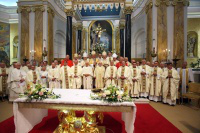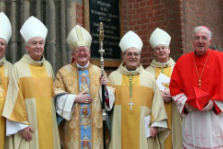London: St Peter's Italian Church celebrates 150th anniversary

Clergy assembled for 150th Anniversary Mass at St Peter's
St Peter's Italian Church in London's Clerkenwell marked its 150th anniversary on Monday 29 April at a special Mass concelebrated by the Archbishop of Westminster, His Grace The Most Rev Vincent Nichols.
Among other senior clergy present, were Cardinal Renato Raffaele Martino, Grand Prior of the Sacred Military Constantinian Order of St George and President Emeritus of the Pontifical Council for Justice and Peace of the Vatican City, Cardinal Cormac Murphy O'Connor, Archbishop Emeritus of Westminster, HE Archbishop Antonio Mennini, Apostolic Nuncio to the Court of St James's, His Grace The Most Rev George Stack, Archbishop of Cardiff, The Rt Rev Alan Hopes, Auxiliary Bishop of Westminster and the Rt Rev Hlib Lonchyna, Eparchial Bishop of the Ukrainian Catholic Eparchy of Holy Family of London were among those con-celebrating.
Special messages of tribute to the Church were read out from HM Queen Elizabeth II, HH Pope Francis and the Vatican Secretary of State, HE Cardinal Angelo Sodano.
The Archbishop of Westminster delivered a speech on the contribution made by this unique Church and of the Italian community which still to this day practice their faith in the hundreds each week. The longstanding and popular Parish Priest, Fr Carmelo Di Giovanni spoke of the great historic moment for his parish and his community.
More than 500 people attended the Mass and a dinner followed in the church hall. Among those attending were senior civic, parliamentary, diplomatic, religious and charitable personalities. Knights and dames of the British and Irish delegation of the Sacred Military Constantinian Order of St George, as an Order of Knighthood fully recognised by decree of the President and Government of the Italian Republic, processed wearing their mantle capes. A dinner was held afterwards at the Church Hall.
Brief History of St Peter's Italian Church
In the early 19th century the Saffron Hill area of London was a poor neighbourhood of densely populated slum-ridden alleys. By 1850, nearly 2000 Italian immigrants had settled there, chiefly employed as itinerant workers - street musicians, organ-grinders, street vendors or as artisans producing plaster figures, picture-frames, looking-glasses, barometers and other scientific instruments. They worshipped at the Royal Sardinian Chapel, Lincoln's Inn Fields, because they had no church of their own.
In 1845 St Vincent Pallotti, a Catholic priest and founder of the SAC (Pallottine Fathers), thought of constructing a church in London for Italian immigrants. The Irish architect, Sir John Miller-Bryson, modelled the church on the Basilica of San Crisogono in Rome.
Originally it was meant to hold 3,400 people, but the plans were scaled down. It was consecrated as 'The Church of St Peter of all Nations' on 16 April 1863 and, at that time, it was the only church in Britain in the Roman Basilica style.
St Peter's opened amid great celebration on 16th April 1863, at that time the only church in Britain in the Roman Basilican style. The Irish architect John Miller Bryson worked from plans drawn by Francesco Gualandi of Bologna, which in turn were modelled on the Basilica of San Crisogono in Trastevere, Rome. St Peter's was originally the 'Church Of All Nations' and throughout the 1860s attracted congregations of many nationalities. A Polish chapel was established in the crypt. The excellence of the music attracted people of many faiths.
The choir was outstanding and regular concerts were held, featuring distinguished soloists and orchestras. The Italian Church, as it soon became known, established itself with great success. The choir loggia and organ were built in 1886. The magnificent organ which can be seen today is part of the original by the Belgian craftsman Anneesen and it was regarded as the finest in the country at the time of its installation. It was restored in 1959 using many of the original features, and again in 1995. Maintaining the tradition of fine singing at St Peter's, it has accompanied may exceptional singers, including the great tenor, Beniamino Gigli.
Looking up from the central nave, the ceiling is dominated by a fresco depicting St Peter in triumph, carrying symbols of his authority and martyrdom (Gauthier of Saluzzo 1896) Enough money was found to complete the presbytery in 1865-66. The campanile and new loggia on Clerkenwell Road were designed by Francis Tasker and completed in 1891.
The façade of the church consists of a loggia and a portico with two arches, above which are three alcoves. The central alcove contains a statue of Christ, whilst the side alcoves contain statues of St Bede and St George. Between the alcoves are two large mosaics depicting the miracle of the fishes and Jesus giving the keys of the Kingdom of Heaven to St Peter. Above the façade is a 33-metre-high bell tower, built in 1891 which houses a huge bell known as 'The Steel Monster'. In the loggia are two important plaques, one to veterans of the First World War and the other to 446 Italians who lost their lives on the Arandora Star.
During the Second World War many Italians resident in Britain were interned. During the period of internment, from 1939, the church was under the control of the Irish Pallottines, only reverting to the Italians Province in 1953.
For more information on St Peter's Italian Church see: www.italianchurch.org.uk

















